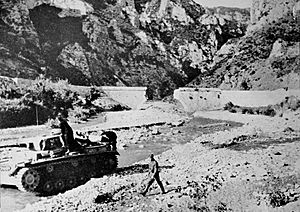Battle of Thermopylae (1941) facts for kids
Quick facts for kids Battle of Thermopylae (1941) |
|||||||
|---|---|---|---|---|---|---|---|
| Part of the German invasion of Greece | |||||||
 German forces in Thermopylae following the battle |
|||||||
|
|||||||
| Belligerents | |||||||
| Commanders and leaders | |||||||
| Units involved | |||||||
| Australia: 19th Brigade New Zealand: 6th Brigade |
6th Mountain Division 5th Panzer Division |
||||||
| Casualties and losses | |||||||
| unknown | 100 casualties 15 tanks destroyed |
||||||
The Battle of Thermopylae was a fight during World War II. It happened on April 24–25, 1941. This battle was part of the German invasion of Greece.
Contents
Why the Battle Happened: Setting the Stage
After some earlier fights, Allied soldiers had to pull back. These soldiers were from British Commonwealth countries like Australia and New Zealand. They decided to set up new defenses at a famous place called Thermopylae. This area was known for an ancient battle in 480 BC.
Setting Up Defenses at Thermopylae
The New Zealand 2nd Infantry Division was in charge of defending the main pass. This division was led by Lieutenant-General Bernard Freyberg. At the same time, parts of the Australian 6th Infantry Division defended a nearby village called Brallos. Major General Iven Mackay led the Australian forces.
New Zealand's Positions
The 5th Brigade from New Zealand was placed along the coast. They guarded bridges near the Spercheios River. The 4th Brigade watched the coast on the right side. The 6th Brigade was kept in reserve, ready to help.
Australia's Positions
The Australian forces at Brallos were mainly from the 19th Brigade. Brigadier George Vasey was their leader. More Australian battalions joined them on April 19 and 20.
Plans to Retreat
At first, leaders like Freyberg and Mackay told their soldiers they would not retreat. But higher-up commanders were already planning an evacuation. Mackay later said he thought they would fight for about two weeks.
On April 21, German planes saw that the Allied defenses were not very strong. They also noticed British troops leaving Salamis Island.
On April 23, the ANZAC Corps was ordered to pull back. It was decided that a small group of soldiers would stay behind. They would hold Thermopylae and Brallos for as long as possible. This would allow other Allied units to get away safely.
The New Zealand 6th Brigade and the Australian 19th Brigade were chosen for this important job. Brigadier Harold Barrowclough led the New Zealanders. Brigadier Vasey, leading the Australians, famously said they would "hold its present defensive positions come what may." This meant they would stay until the main retreat was finished.
The Battle: Fighting at Thermopylae
On April 24, 1941, German forces attacked at 11:30 AM. A German battlegroup, led by Generalmajor Ferdinand Schörner, faced strong resistance. Another German group, from the 5th Panzer Division, also joined the attack.
German Tanks Attacked
In the early afternoon, German tanks were hit by Allied artillery near Lamia. The Allied guns could fire down into the pass from hidden spots. Two German tanks tried to break through the lines of the 25th Battalion. But long-range field guns destroyed them.
Later that day, four German tanks and some infantry soldiers in trucks tried to take a position. They moved towards the 6th Brigade's area. After some confusion, the Allies pushed them back. They used 2-pound and 25-pound field guns.
Allied Withdrawal
The Allied rearguard had done its job. They had held the Germans back long enough. Now, they began to destroy any equipment and guns they could not take with them. Then, they retreated towards another defense line at Thebes.
The last Allied vehicles left by midnight. The Germans did not take Thermopylae until three hours later. They launched a formal attack on the empty positions. The Allied forces had held their ground for the planned time. They had also destroyed about 15-16 German tanks and caused many German casualties.
What Happened Next: After the Battle
The German army continued to advance through Greece. They eventually occupied the entire country.
The Greek Army did not take part in this battle at Thermopylae. This was because General Georgios Tsolakoglou had already surrendered. After the war, some people in Greece felt this was a "shame" for the Greek government. They believed Greece should have fought at such an important historical site.
See also

